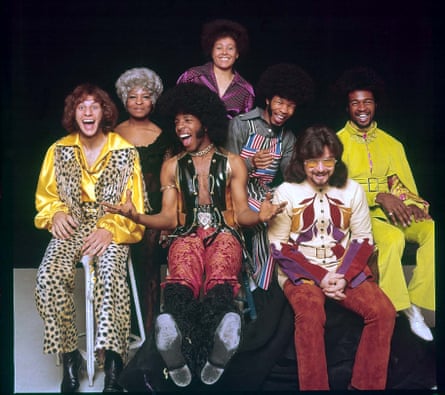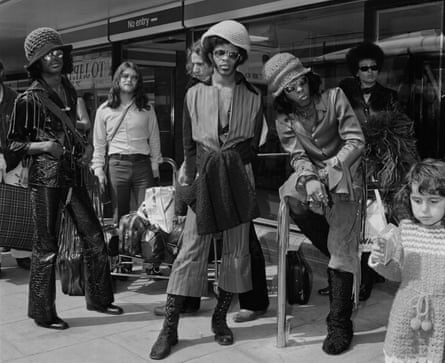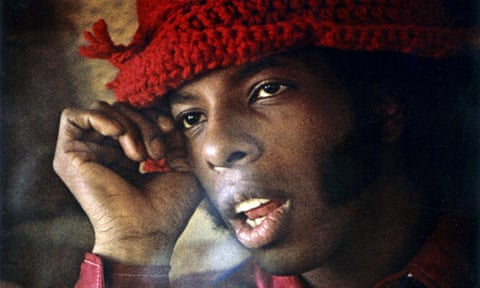20. Crossword Puzzle (1975)
More straight-ahead funk than the albums that had made his name, High on You is nevertheless the last Sly Stone album that anyone but an obsessive might want to listen to all the way through. The best track is Crossword Puzzle – its tight groove subsequently sampled by De La Soul – although, ominously, it was a leftover from the previous year’s Small Talk.

19. Get Away (2011)
Stone’s most recent album, I’m Back! Family & Friends, is a miserable affair: pointless re-recordings of old classics; a belief-beggaring bro-step take on Family Affair. Yet, there is also the drum-machine-driven, fabulously hooky Get Away, which, had it been better recorded, might have been a comeback single. Hearing it is heartening and frustrating.
18. Remember Who You Are (1979)
By now, we are deep into Stone’s extended twilight years, spotted with weak albums that seem to signpost their desperation in their titles – Heard Ya Missed Me, Well I’m Back and Back on the Right Track. Still, he could, occasionally, come up with the goods: here, sister Rose and brother Freddie are on vocals for a low-key but killer song.
17. Underdog (1967)
Sly and the Family Stone’s debut album, A Whole New Thing, didn’t quite deliver on the promise of its title. It sounds like traditional soul by comparison with what was to come, but is still worth hearing: the opener, Underdog, is paranoid, fabulously funky and powered by razor-sharp brass.
16. Can’t Strain My Brain (1974)
Devotees tend to view the Small Talk album as Stone’s most personal and on Can’t Strain My Brain, over the most recumbent of laid-back grooves, he certainly seems to hint at the chaos his addictions and volatility have caused: “I know how it feels to worry all the time, I can’t take the pain.”
15. Dynamite (1968)
A commercial disappointment after Dance to the Music, the Family Stone’s third album, Life, deserved far better: it was a creative leap forward, as demonstrated by its urgent opening track. The guitars sting more sharply, and the risks it takes – a cacophonous, echo-laden climax, a weird, beatless Dance to the Music-quoting coda – are greater.

Larry Graham, Jerry Martini, Gregg Errico, Sly Stone, Freddie Stone and Cynthia Robinson. Photograph: Evening Standard/Getty Images
14. Everybody Is a Star (1969)
The last track released by the classic Family Stone lineup – with drummer Greg Errico, who bailed when things got too drugged-out – has a suitably elegiac quality, and a hint of southern soul influence about its pleading, organ-heavy sound. The vocals, in which everyone gets a turn at the mic, are a final display of soon-to-be-fractured unity.
13. Fun (1968)
Life might have been a more successful album if they had picked Fun as a single, rather than the circus-themed novelty of the title track and the Dance to the Music redux of M’Lady. There is an infectious euphoria about its invitation to party and a bit of Sly philosophy thrown in: “Sock it unto others as you would have them sock it to you.”
12. Luv N’ Haight (1971)
Peer through the murk, and you can make out a song the Family Stone would once have turned into an irresistible order to dance, but times had changed: here, it feels muted, its drum pattern sounds twitchy, the lyrics an ode to rendering yourself supine as a desperate means of escape.
11. You Can Make It If You Try (1969)
The closing track from Stand! hymned confident self-reliance amid the turmoil of the US in the late 60s, set to blasting brass and terrific drum breaks: precisely the kind of optimism that would be noticeable by its absence from the Family Stone’s next album. Still, it was energising and inspirational while it lasted.
10. Runnin’ Away (1971)
Runnin’ Away sums up the creepiness of There’s a Riot Goin’ On. Its melody is nursery-rhyme like in its simplicity, amplified by the childlike vocal, and the trumpet feels perky, but it is all caked in alienating distortion and the lyrics appear to laugh at their protagonist’s hopeless plight. Its eeriness gets under your skin.
9. If You Want Me to Stay (1973)
By 1973, things were completely out of control in Stone’s world, and yet he still made Fresh, a brilliant album that turned There’s a Riot Goin’ On’s muffled, elastic sound to more concise, commercial use. His final hit, If You Want Me to Stay, is an understated masterpiece of insouciant soul.
8. Stand! (1969)
The title track of their first classic album was as gospel-influenced as Sly and the Family Stone ever got: the chorus soars heavenwards, the moment, a minute before the end, where the song explodes into a breakbeat is fabulous, and “You’ve been sitting much too long, there’s a permanent crease in your right and wrong” is a great lyric.
7. Sing a Simple Song (1969)
If the late Cynthia Robinson’s greatest vocal interjection is Dance to the Music’s “All the squares go home!”, the second is her roar of Sing a Simple Song’s title. The flip side of Everyday People in every sense, it offers thrillingly raw, uncut funk. And the live version in the Summer of Soul documentary is a monster.
6. Hot Fun in the Summertime (1969)
Stone’s earliest bands dealt in doo-wop, a genre that seemed to infect Hot Fun in the Summertime nearly a decade on. It is a glorious single, and beautifully orchestrated, which is a rarity for the Family Stone. Sun-drenched, carefree and wistfully autumnal in equal measure, it also unexpectedly provided the inspiration for Genesis’s 1981 single Misunderstanding.
5. Dance to the Music (1967)
Their label’s demand for a commercial single resulted in a song derided by Sly and the Family Stone as “unhip” and “glorified Motown”, a baffling assessment both of Dance to the Music’s pounding exuberance and subsequent influence: its distorted guitars and shifting sound changed Motown, almost singlehandedly ushering in the psychedelic soul era.
4. Thank You (Falettinme Be Mice Elf Again) (1969)
Intended for an unfinished follow-up to Stand!, Thank You (Falettinme Be Mice Elf Again), which debuted the hugely influential slap bass technique invented by Larry Graham, ended up a farewell to the party-starting original Family Stone sound: the lyrics run down their hits, but twitchy lines about guns and the devil hint at what is to come.
3. Everyday People (1969)
Sly and the Family Stone’s first US No 1 has been endlessly sampled and covered by everyone from Miles Davis to Maroon 5 to Belle and Sebastian. Everyday People distils the band’s initial essence – multiple vocals, propulsive bass, lyrics preaching tolerance in a fractured US – into two minutes and 22 seconds of perfect pop.
2. Family Affair (1971)
Possibly the bleakest US No 1 single ever, Family Affair draws a firm line under 60s idealism. Rose Stone’s blank-eyed delivery of the hook; its fatalistic lyrics given a shrugging, so-what? twist by Sly’s stoned drawl; the muffled, distorted sound lending a claustrophobic, etiolated quality to its muted funk. Chilling and incredible.
1. I Want to Take You Higher (1969)
There’s a Riot Goin’ On might be their greatest album, but if you wanted to explain to someone what made Sly and the Family Stone so special, you would play them I Want to Take You Higher, a riot of its own: an impossibly exciting flashpoint of raw-throated vocals, fuzzed-out bass, dive-bombing guitar riffs and drumming as relentless as its lyrical invitations to dance (or take drugs, or indeed both). It is the gleeful zenith of Sly and the Family Stone’s first, groundbreaking phase, before darkness and disillusionment set in, and is as compelling and overwhelming today as it was more than half a century ago.
